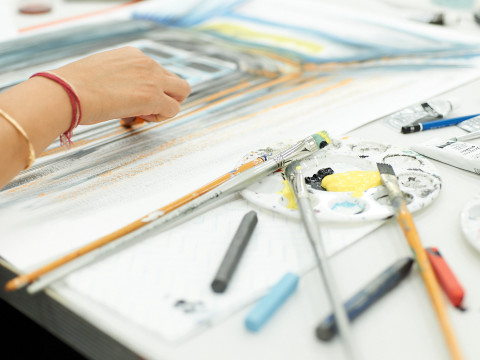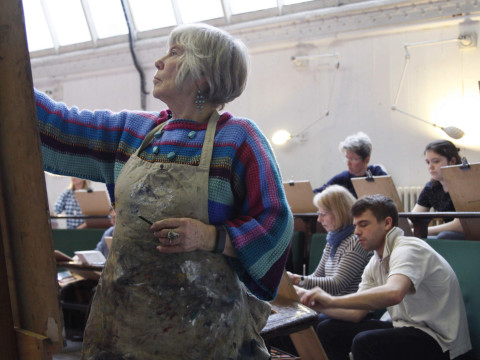
How to build, prime and paint a canvas
Weekend-long practical course
27 October 2018 10.30am - 5.30pm28 October 2018 10.30am - 5.30pm
The Clore Learning Centre, Burlington Gardens, Royal Academy of Arts
£480. Includes all materials, lunch and a wine reception at the end of the first day.
Klimt / Schiele
Terms and conditions
Led by award-winning painter and figurative artist Andy Pankhurst, this practical course will teach the traditional techniques used to build and prepare a canvas, as well as how to use oil paints to paint from life.
'All good pictures crack!'
Sir Joshua Reynolds PRA (1723 – 1792)
Cave artists drew and painted on organic surfaces such as rock. Ancient Egyptian and Greco-Roman artists painted portraits onto linen to adorn mummy cases, as well as on prepared walls and rigid wooden panels with various media. Such techniques flourished into and throughout the Renaissance. It was not until the latter part of the fifteenth century and beginning of the sixteenth century, notably in Venice, that artists began to paint in earnest on stretched and prepared linen canvas.
The artist today has a far more varied choice of paints, supports and grounds to work with than in the past, including acrylic paint made with polymer binders rather than traditional oil, acrylic primers and gessos rather than carbonate of lead and linseed oil, and natural rabbit skin glue and calcium sulphate (chalk).
However, oil paint on canvas is still used in the same way as in Titian’s day and, one can argue, however much innovation and new technologies offer the artist, nothing has surpassed the permanence, beauty and tactility of oil paint on canvas.
An understanding of the methods and materials of the painter’s craft is essential for anyone who endeavours to paint. Knowledge of a picture’s structure can be fundamental to its success and longevity. This all begins with the support and the ground that the paint sits on.
This exciting two-day practical painter’s craft and life-painting course is led by artist and expert tutor Andy Pankhurst.
£480. Includes all materials, lunch and a wine reception at the end of the first day.
Klimt / Schiele
Terms and conditions
About the course
A two-day life-painting course in oils in which participants will work directly from a model, while learning some of the painter’s craft through the traditional techniques of preparing and constructing a canvas.
Participants will put together and stretch a linen canvas onto wooden stretcher bars; be shown the correct technique and type of brushes to size the canvas using traditional rabbit skin glue; make an oil primer from egg, linseed oil and Titanium White pigment; and learn the correct technique to prime the canvas.
Day one
• Initial drawing from the life model
• Introduction to oil paints and demonstration of building and preparing a canvas and glue size
• Painting from the life model/building and sizing your canvas
Day Two
• Demonstration of making a traditional oil primer and application
• Priming canvases
• Painting from the life model continues
Participants are advised to bring something to carry work home in, as there are no storage facilities available.
This course takes place in the new Clore Learning Centre at the Royal Academy in Burlington Gardens.
This course is suitable for all levels, but participants will ideally have some prior experience of drawing, painting or creative practice in general.
This course is for you if:
• You have some prior knowledge of drawing and/or painting and would like to extend your skills by working from direct observation.
• You would like a new perspective in your approach to life painting.
• You would like to develop your knowledge of and skills in working with oil paint.
• You have no prior experience of life painting but have an interest in the history, theory and practice of art more generally.
• You would like the opportunity to develop your skills within a small group in the Royal Academy’s Clore Learning Centre.
Minimum age 18
The number of participants is strictly limited to enable detailed feedback from the course tutor.
£480
Saturday 27 – Sunday 28 October 2018
10.30am – 5.30pm on both days
Includes:
• An introduction to the RAwith particular reference to works in the Collection
• All specialist practical art materials
• Course learning materials and hand-outs
• The opportunity to work from a professional life model on both days
• Lunch and refreshments on both days
• A drinks reception at the end of the first day
• A certificate of participation upon course completion

About the tutor
Andy Pankhurst
Upon graduation from the Slade School of Fine Art in 1992, Andy Pankhurst won first prize in the Windsor and Newton Young Artist’s Award and was represented by leading gallery Anthony Mould Contemporary Ltd.
In the same year, he was awarded the Richard Ford Scholarship by the Royal Academy, with which he travelled to Spain to study the Old Masters in the Prado. He subsequently became a committee member of the award in 2003, nominated by Christopher Le Brun PRA, alongside former Keeper of the Royal Academy, Maurice Cockrill RA. Through the Boise Travel Scholarship, he later lived in the Veneto area of Italy, studying primarily Giotto and the Venetian School.
As a figurative painter, Andy Pankhurst is known as an artist and teacher working from the life model. Andy’s work is represented in various public, corporate and private collections and museums in the UK and USA. Andy currently exhibits with Browse and Darby in London, with his most recent show of paintings and drawings in 2014. He is the co-author with Lucinda Hawksley of the book What Makes Great Art?, published in 2012 by Apple Press.

Our courses and classes programme
Our programme of short courses and classes offers the opportunity to explore a range of subjects, led by expert tutors and practising artists.
Related events
 Short courseFree
Short courseFreeThe Primary Art School
9 January - 12 June 2025
 Short course
Short courseModernism around the world
4 February - 11 March 2025
 Short course
Short coursePortrait photography: ideas from modernism
15 February - 16 February 2025
 Short course
Short courseThe Art of Carnival
1 March 2025
 Short course
Short courseBotanical art
11 March - 8 April 2025
 Short course
Short courseExploring ink: method and imagination
29 March - 30 March 2025
 Short course
Short courseDepicting the figure: Renaissance to Modernism
29 April - 27 May 2025
 Short course
Short courseRevolutionaries and Romantics: art and literature in France
17 May - 18 May 2025
 Short course
Short courseOil painting: techniques and discovery
17 May - 18 May 2025
 Short course
Short courseSketch with stitch
21 June - 22 June 2025
 Short course
Short courseConnoisseurship summer school: who painted what, when and how to tell
1 July - 5 July 2025
 Short course
Short courseLife drawing summer school
8 July - 12 July 2025
 Short course
Short courseDrawing with anatomy
15 July - 19 July 2025
 Short course
Short courseExpressive life drawing: observation and imagination
15 July - 19 July 2025
 Short course
Short courseLandscapes: van Gogh and his influence
2 September - 6 September 2025